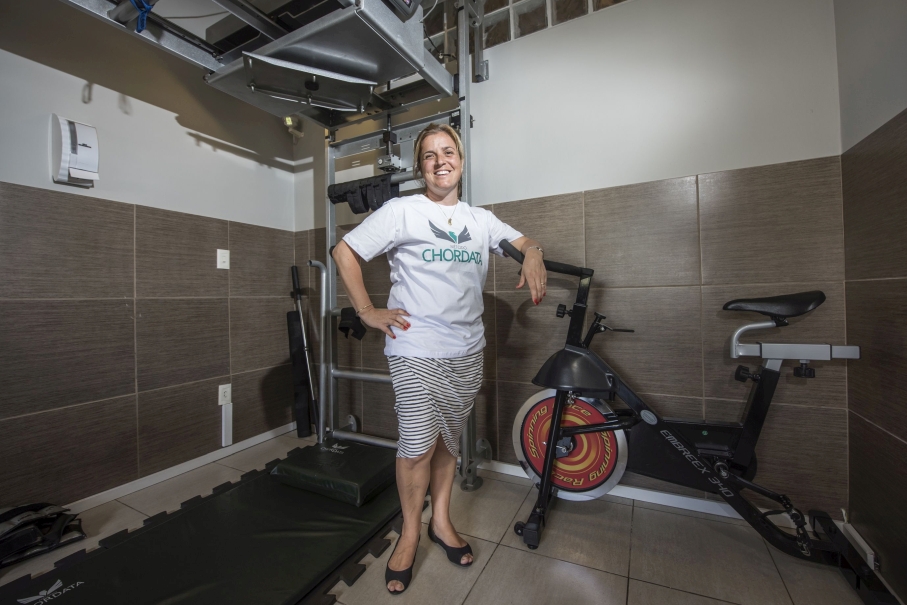Unprecedented therapy proves to be more effective and help patients to walk again
Por: PUCRS Magazine

Physiotherapy professor Veronica Frison has designed the method, equipment and exercises. Photos: Camila Cunha – Ascom/PUCRS
What is your aspiration in life? Some people would say they would like to be a successful professional, others would choose to travel around the world, start a family or make a difference in life. But for many, their goal is to be able to walk again, or walk for the first time. Veronica Baptista Frison, a Professor in the Physiotherapy program, has been devoting her time to help patients who want to accomplish this dream, for 15 years. She designed not only the unprecedented Chordata Method, but also a specific machine and a set of exercises, both designed by her.
The method makes use of two types of exercises, tilting and suspension, thus enabling the suspension of body segments and lifting up the patient’s full body. The sessions can be carried out with a lying, standing or sitting patient, emphasizing the repetition of the movements and resistance for a longer period of time. “In view of that, I worked on exercises that were biomechanically and neuroscientifically reasonable. I noticed that patients would produce different results when they made use of the equipment compared to when they made use of traditional physiotherapy”, remarks Veronica.
Restored Hope
Based on the Chordata Method, a set of investigations embraced by the Physiotherapy Program began in order to testify the effectiveness of the technique. Around eight undergraduate thesis, a Master’s thesis, advised by Professor Irenio Gomes, from the Institute of Geriatrics and Gerontology (IGG), and a dissertation involving 120 Parkinson’s patients have been written. “I’ve got many students involved and the clinical response has been positive”, remarks the Professor.
Quality of life
The study on the elderly population involved 72 people who, after 16 sessions, showed improvements verified in tests such as time up and go, Bergen’s scale and reach test. “Compared to other techniques, the fact that we have achieved better results from 16 sessions shows its effectiveness with a significant gain. Even before the end of the test, we could see improvements from participants’ testimonials. They claim to be stronger and be able to stand up”, remarks Veronica.
PUCRS professionals
The equipment designed by Professor Veronica Frison is made of steel, springs, tissues, vests and belts. It became a reality after many studies that involved engineering and design, which included prototyping, testing and her own funding, came about due to her partnership with various companies related to material production. She’s the one who puts together the equipment, designs the exercises and owns the method’s patents. She conducted training sessions with 9 PUCRS graduates from the Physiotherapy Program. Many of the students go to the institute to carry out research. Patients taking part in the tests are not charged any fees.
The equipment will lift their bodies as a whole. As the person does not need to lift their body to move, it will bring about more resistance in the muscles which gain force over time, as they will be able to stand and walk. Veronica explains that the method can be applied to treat any injuries that bring about any form of paralysis, regardless of what originated it (stroke, accident, cancer, brain injury or disease) or the person’s age. “Clinically speaking, the patient will be able to walk again, with some degree of difficulty, but they will be able to drive, work and go back to their normal life”.
To find out more about it, please visit PUCRS Magazine 2016 annual issue.